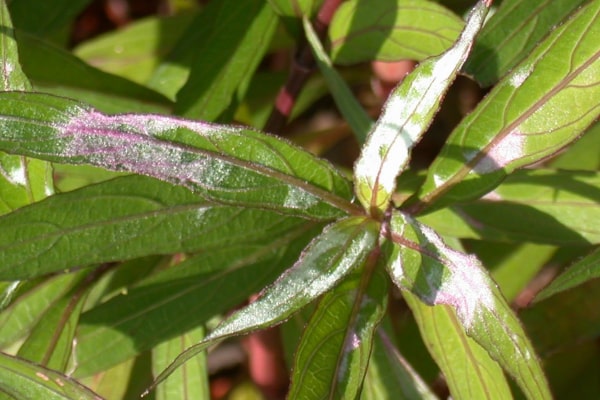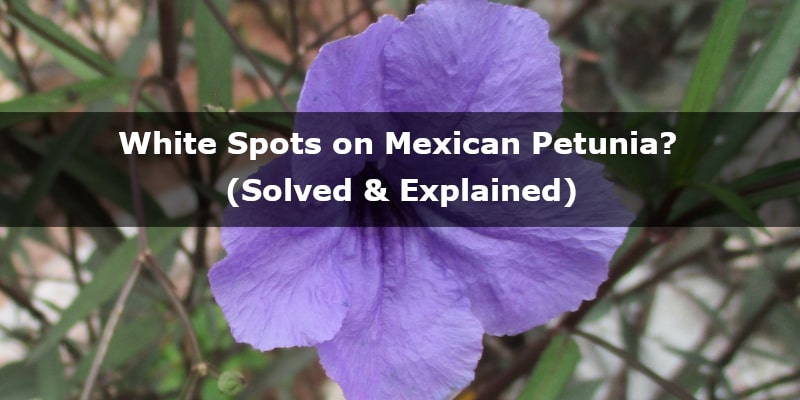You’ve noticed white spots on your Mexican petunia?
Don’t worry. As an experienced gardener, I know what might be the reasons, and I will tell you how to revive your ruellia.
What are the White Spots on Your Mexican Petunia?
The white spots on your Mexican petunia might be a sign of insects, viruses, or fungi like thrips, botrytis, or powdery mildew. White spots might also occur because of fertilizer damage or nutrient deficiency.
Mexican petunia is susceptible to many kinds of fungi, insects, or viruses. Thus, powdery mildew, thrips, or erineum are probably damaging your plants. However, there are more causes.
The good news is that in every case, you can revive your ruellia.
In this post, I listed all the possible causes of white spots on your Mexican petunia, their symptoms, and ways to rejuvenate your flower.
Powdery Mildew
Powdery mildew is a fungus that attacks most plants. It creates powdery white spots, mostly on the leaves, but also on flowers, and stems. The white spots are sometimes fluffy.
Later, there might be black spots appearing on the black spots. If powdery mildew isn’t treated soon enough, the leaves might become twisted, and get yellow.
Powdery mildew can occur if you keep your Mexican petunia in humid conditions, where air circulation is poor, plants are spaced too tightly, and you tend to water the plant from above.
If you suspect that the powdery mildew is the problem, there is a way to treat this disease. The most important thing is spraying the plant with neem oil (buy on Amazon here). To prevent the spread of disease, water your ruellia from below, provide good air circulation, and don’t overcrowd your plants.
Thrips
Thrips are little insects with fringed wings that feed on other insects by puncturing them and sucking out their insides. If you want to make sure that thrips are present on your Mexican petunia, look for tiny, fat ants that are running around on your plant.
They carry viruses to your ruellia, and scrape away plant tissue. As a result, the leaves turn papery with bleached spots or streaks. The foliage might also get deformed. White, or silvery spots also appear on the flowers.
Eliminating thrips completely isn’t recommended, because you might also kill beneficial bugs. The safest thing is to control thrips. In order to do that, you should prune highly affected areas of your Mexican petunia, and apply neem oil, opyrethrins, or insecticidal soap.
ErineumÂ
Erineum is a fungal disease, often mistaken for powdery mildew. It is caused by tiny eriophyid mites. The fungi are only visible through a microscope.

Affected ruellia is developing white woolly patches on their leaves and stems. The patches can be spotted usually underneath the leaf, and are sometimes reddish. Leaf distortion is also possible.
Erineum isn’t deadly for your plant, and it won’t cause any side effects besides a worse look. Thus, treatment isn’t necessary. However, if you want to get rid of erineum, a 2% horticultural mineral oil solution repeated 3 times at 7 to 10-day intervals should help.
Nutrient Deficiency
Light-colored spots on the foliage might be the cause of the nutrient deficiency. There are several nutrients that your Mexican petunia might need.
Iron: The deficiency of this nutrient first appears as yellowing between leaf veins, while young leaves turn completely white or light yellow.
Zinc: If there’s not enough zinc, leaves develop chlorosis, causing them to twist. Then, leaves develop tan or white dead patches.
Potassium: Lack of potassium causes Mexican petunia leaves to develop yellow-green patches between veins that become tan dead spots, and the entire leaf withers ultimately.
Applying a balanced fertilizer should help. You can buy this one on Amazon.
Fertilizer Burn
If you already use fertilizer on your Mexican petunia, it’s possible that you have over-fertilized the plant. As a result, there’s too much salt in the soil, which damages the roots.
The signs of over-fertilization include burns and white spots on the leaves and flowers.
To alleviate over-fertilization and excess salt buildup, place the plant in the sink or other suitable location and thoroughly flush it out with water, repeating as needed 3-4 times. Remember to allow the plant to drain well in between watering intervals.
Botrytis Blight Infection
Botrytis Blight Infection is another common fungal infection of Mexican petunia. These fungi thrive in wet, humid conditions.
The signs of this infection present themselves as tiny white spots on petunias that, eventually, turn into a gray, powdery mess that completely destroys the flower.
However, if you act fast, you can revive your ruellia. To do that, deadhead the plants and clean up dead plant material. Then, remove infected plants and destroy them, if you don’t want to spread the fungi.
Sources
hunker.com, gardeningknowhow.com, dougsbugs-n-shrubs.blogspot.com, hortnews.extension.iastate.edu, homeguides.sfgate.com

